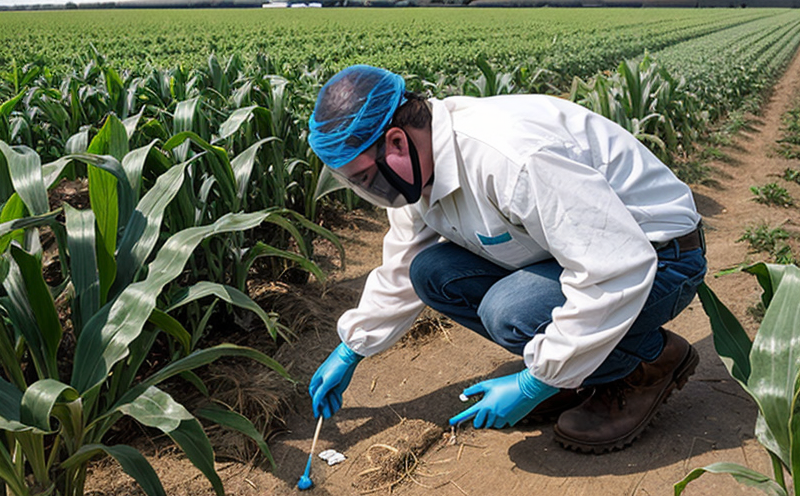Chlorothalonil Residue Testing in Crops
Chlorothalonil is a widely used broad-spectrum fungicide known for its effectiveness against a variety of fungal diseases. Its extensive use, however, raises concerns about potential residue levels that may affect food safety and quality. This service focuses on the accurate detection and quantification of chlorothalonil residues in crops to ensure compliance with international standards and regulatory requirements.
Testing for chlorothalonil involves several critical steps, including sample collection, preparation, and analysis using advanced analytical techniques such as Liquid Chromatography-Mass Spectrometry (LC-MS/MS). The goal is to determine whether the pesticide residue levels are within acceptable limits set by various regulatory bodies. Compliance with these standards ensures consumer safety and maintains market access for agricultural products.
Our laboratory employs state-of-the-art equipment and methodologies that adhere strictly to international standards like ISO 17025, ASTM E1641, and EN 13981. These standards provide a robust framework for ensuring the accuracy and reliability of our testing results. We also conduct proficiency testing programs regularly to validate the precision and accuracy of our analytical methods.
For crops like tomatoes, apples, and grapes, chlorothalonil is frequently used due to its broad-spectrum fungicidal properties. However, overuse can lead to residues that exceed acceptable limits, posing risks to human health and environmental sustainability. Our testing service plays a crucial role in preventing such issues by providing precise data on pesticide residue levels.
When conducting chlorothalonil residue tests, it is essential to follow strict protocols for sample preparation and handling. This includes minimizing contamination during collection and ensuring that the samples are stored under controlled conditions until analysis. The analytical process itself requires careful calibration of instruments and adherence to standardized procedures to ensure accuracy.
The results of our chlorothalonil residue tests are reported in parts per million (ppm) or micrograms per kilogram (µg/kg), depending on the unit specified by regulatory bodies. These reports provide critical information for stakeholders involved in production, distribution, and retail sectors. By ensuring that crops meet established safety standards, we contribute to maintaining public trust in agricultural products.
In conclusion, accurate chlorothalonil residue testing is vital for upholding food safety standards and promoting sustainable agricultural practices. Our comprehensive service not only meets but exceeds the requirements set by international standards, providing reliable data that support informed decision-making across various sectors of agriculture and forestry.
Applied Standards
| Standard | Description |
|---|---|
| ISO 17025 | International standard for the competence of testing and calibration laboratories. |
| ASTM E1641 | American Society for Testing and Materials method for the analysis of pesticide residues in food products using LC-MS/MS. |
| EN 13981 | European standard for the determination of pesticide residues in agricultural products. |
The application of these standards ensures that our testing methods are rigorous and consistent, providing reliable data that meet regulatory expectations. Compliance with these internationally recognized standards enhances the credibility of our results and supports the broader goal of ensuring safe and sustainable agricultural practices.
Benefits
Accurate chlorothalonil residue testing offers numerous benefits to stakeholders in agriculture and forestry. For producers, it ensures that their products comply with local and international regulations, thereby reducing the risk of product recalls or bans. This not only protects brand reputation but also facilitates market access to a wider range of consumers.
For distributors and retailers, reliable residue test results provide assurance that they are handling safe and compliant products. This builds consumer confidence and enhances trust in the supply chain. Additionally, compliance with regulatory standards can lead to reduced liability risks and improved operational efficiency.
In terms of environmental sustainability, chlorothalonil residue testing helps minimize the risk of overuse, which can lead to harmful effects on ecosystems. By ensuring that pesticide residues are kept within acceptable limits, our service contributes to a more sustainable approach to agriculture.
For researchers and development engineers, accurate residue test data provide valuable insights into the efficacy and safety profile of chlorothalonil in various crops. This information can be used to refine application methods and improve overall crop health while minimizing environmental impact.
Quality and Reliability Assurance
At our laboratory, we prioritize quality and reliability in all aspects of our operations. Our commitment to excellence is reflected in the rigorous training of our personnel, the use of cutting-edge instrumentation, and adherence to strict quality control protocols.
All our staff members undergo extensive training to ensure they are proficient in using advanced analytical techniques like LC-MS/MS. Regular calibration and validation of instruments further enhance the precision and accuracy of our results. Additionally, we participate in proficiency testing programs organized by recognized bodies such as the International Laboratory Accreditation Cooperation (ILAC) to validate our analytical methods.
Our laboratory is accredited under ISO 17025, ensuring that all tests conducted meet high standards of technical competence and reliability. This accreditation provides a strong foundation for trust in our results and supports our mission to deliver accurate and reliable data.
We also maintain detailed quality control records for each test performed, allowing for traceability and accountability throughout the entire testing process. These records include information on sample preparation, instrument calibration, method validation, and final results. This comprehensive approach ensures that every test result can be audited and verified if necessary.





